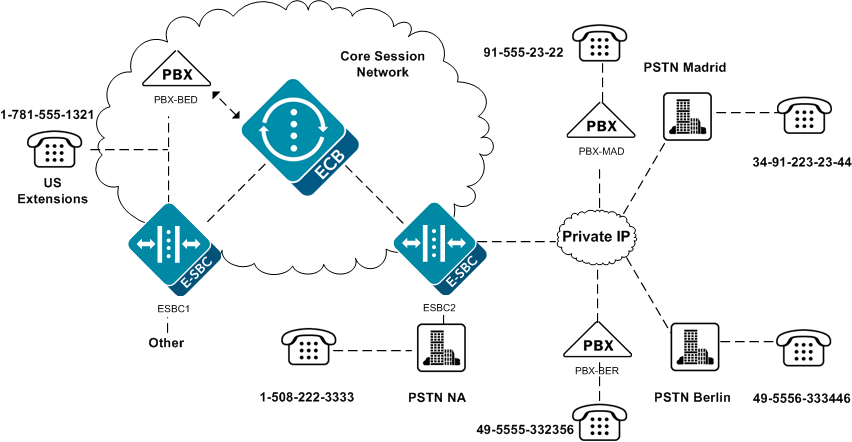Small Enterprise Model
The following diagram shows example extension numbers for the small enterprise model that must be reachable. The key characteristic for this model is the absence of overlap of dial patterns, called contexts, across branch locations.

The following tables define an example of the dial plan called
acme for a small enterprise.
The following table shows dial patterns configured for the
acme
context.
| Prefix | Pattern | Country Code | Replace Prefix | Replace URI | Go To Context |
|---|---|---|---|---|---|
| 1xxx | 1 | 781555 | |||
| 2xxx | 34 | 91555 | |||
| 3xxxxx | 49 | 5555 |
Applicable user database entries.
| Number | Dialing Context | Agent |
|---|---|---|
| +17815551xxx | PBX-BED | |
| +34915552xxx | PBX-MAD | |
| +4955553xxxxx | PBX-BER |
Child contexts inherit the rules of the corporate context, acme, and are also configured to inherit the geographic location contexts for the countries in which they reside.
Regarding the configured routes, numbers preceded with the appropriate country code that do not match these dial patterns go to the PSTN of their respective countries.
Reviewing the fields that do not require configuration is equally instructive. Based on the inheritance of rules from parent contexts, a means of basic access is available throughout the enterprise. In addition, based on the higher precedence of child context configurations, these fields are available to you to configure for special requirements at the separate branches.
This configuration generates the results shown in the following table.
| From | Dial String | Transformation | Result |
|---|---|---|---|
| acme | 1321 | +17815551321 | Call is directed to PBX-BED as e.164 |
| acme | 2322 | +345552322 | Call is directed to PBX-MAD as e.164 |
| acme | 332356 | +495555332356 | Call is directed to PBX-BER as e.164 |